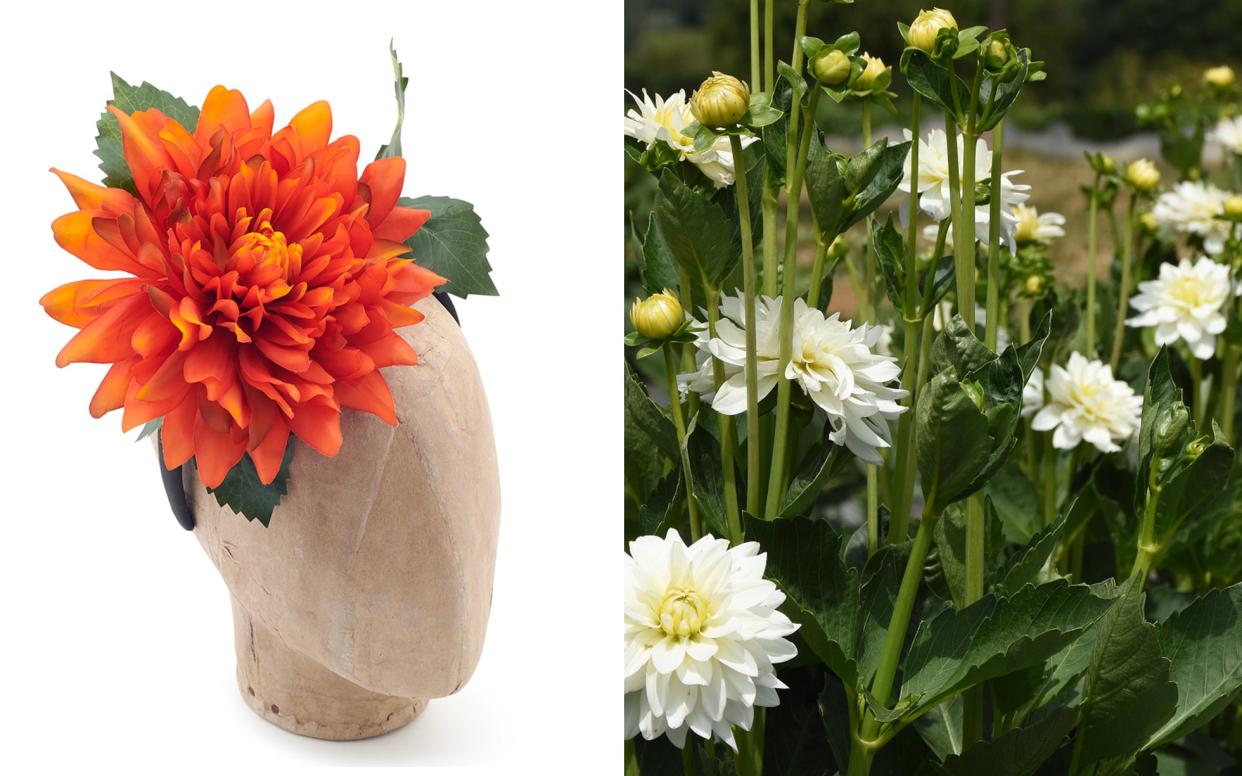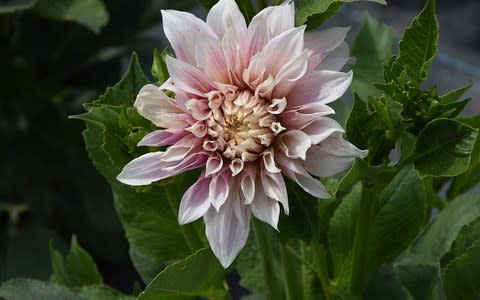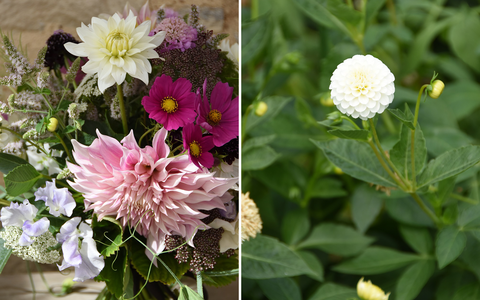Dahlias: nude neutrals or flaming, Frida Kahlo-inspired fiestas?

"I used to loathe dahlias with a passion. When I got married, I banned them. But now I’m horrified, because now I think they’re just exquisite," admits Willow Crossley, fashion’s favourite floral stylist and the author of Flourish: Stunning Arrangements with Flowers and Foliage for Every Season.
Dahlias are the cutting flower du jour, and will continue flowering in Britain until the first frosts, around the end of October. Pinterest is abloom with the long-flowering perennial, native to Mexico (scroll down for Willow's guide to creating the perfect hand-tied bouquet).
Blame the heatwave, social media and the Frida Kahlo fever inspired by the V&A's Making Herself Up exhibition, but it's tempting to be lured into a fiery fiesta of orange and cerise - even if you don't intend to let the quest for the perfect Instagram shot dictate. Life imitates art, after all.
Royal florist Philippa Craddock, who designed the flowers for Prince Harry and Meghan Markle's wedding, has even created an exclusive collection of silk floral head dresses inspired by Frida Kahlo's love of flamboyant flowers, including fuchsias, bougainvillea and dahlias.
A post shared by Flowers from Skye (@flowersfromskye) on Aug 7, 2018 at 2:01am PDT
As well as an artist, Kahlo was also a passionate gardener and florist. Anyone who has visited Casa Azul, her Mexico City home, will rhapsodise about colour, and canna lilies, oleander and cacti - resplendent against cornflower-blue walls.
Just as 'Frida Fever' and the quest to give your home some Kahlo cool has taken hold in the world of interiors and soft furnishings, so have our gardens and floral arrangements been influenced.
A post shared by Sarah Chilton (@chilton_sarah) on Aug 6, 2018 at 2:39pm PDT
But a far meeker, parallel trend for rustic, Tess of the D'Urbervilles-esque pastel, pale pink-hued or coffee-coloured dahlias, like the increasingly popular 'Café Au Lait', laced with petite, virgin-white pom poms may be more to your taste.
Whatever you do, buy home-grown British dahlias, and style them wildly, loosely and casually. "I would never buy dahlias from Dutch breeders, I would only buy them locally," declares Crossley.

As with food, the focus in floristry is now on sustainability and on 'sourcing' flowers nearby, rather than heading straight to the supermarket for blooms which have been flown miles and miles.
Whether you're drawn to bold, bright dahlias reminiscent of baking hot climates, or to a palette of breezier, softer greens, pinks and whites, you can style the stems sparingly in clear glass vases or jars.
Sometimes, mixing too much with dahlias takes away from their beauty, and that way they're allowed to speak for themselves.
A post shared by Thomas Bloom (@thomasbloomflowers) on Aug 6, 2018 at 11:14pm PDT
Personally, I can't help but be drawn to the prettier, paler tones of the country style, such as those I found in abundance in the organic cutting garden at Daylesford farm in the Cotswolds.
Founded by Lady Carole Bamford, working in harmony with nature is the philosophy which drives the cutting garden, where predominantly British home-grown flower varieties - including an array of dahlias - are cultivated.
Unlike most flowers, dahlias cut in full colour and full bloom will last the longest
"If you buy organic fruit and vegetables, it follows that you’ll want to make the same kind of choices about sustainable provenance in other aspects of your life," she explains of her decision to create the cutting garden, which has allowed the farm to host heavenly floristry workshops to visitors and floristry novices such as myself, who can select and cut their own flowers.
"I'm passionate about protecting the habitat and welfare of the bees, and a cutting garden is a means of providing them with different sources of food and nutrients," she adds.
Daylesford's lead floristry tutor Sarah Ann Butler prefers dahlias that are less outlandish than the Kahlo-inspired creations above, and she suggests that I place a covetable 'Café Au Lait' dahlia, a "show-stopping soft, nude pink flower that can grow the size of a dinner plate", in the centre of my seasonal posy.

Surrounded by 'Fleurel' (giant white blooms with a cream centre) and 'Karma Choc' (subtle, chocolate-scented, smaller headed dahlias with a deep burgundy colour), paired with wild carrot and apple mint and scattered with 'Snowflake' (little white pom-poms; the ideal size for both hand-tied posies or bud vases on your bedside table), this is a muted arrangement which is no less show-stopping. Relaxed and open, without wiring or structure, it's tied only with twine.
A post shared by Homeandhound.com (@homeandhound) on Aug 7, 2018 at 7:17am PDT
"Five years ago, dahlias would have been deemed old-fashioned or garish," says Butler. "Now, they're considered so spectacular that increasing numbers of visitors here are drawn to them first when they visit to pick their own flowers."
As cut flowers, dahlias will around five days, if cared for and conditioned. For best results, Butler recommends cutting them first thing in the morning, so the are stems full of water.

"If you pick them at the end of the day, they droop and their vase life is cut in half," she explains. "Put them straight into a bucket of fresh cold water in a cool, dark room for several hours to add several days to their vase life.
"Unlike most flowers, dahlias cut in full colour and full bloom will last the longest, and you should never pick them when they're in bud, because they won't open. "

Willow Crossley: How to make a hand-tied bouquet
Condition your flowers and lay them out in families in front of you
Choose a large lead flower which will become the centre of the bouquet. Holding it in your left hand (if you are right-handed - swap if you are left-handed), add a few stems of foliage around it.
Each time you add a flower, lay it diagonally on top of the last, then, with your free hand, turn the bunch. If you want to create a domed effect, keep adding the flowers slightly lower each time. Always turn in the same direction - this forms a spiral shape and makes it easy to add or remove any wayward stems. If the flowers you’ve chosen are particularly dainty, you might want to add more than one stem before turning.
Keep adding the flowers and remember to turn after each addition. Ideally you don’t want the same flowers next to each other so keep track of what you are doing and hold the bouquet in front of you every so often so you can look at the bouquet as a whole.
When you are happy with the shape and size of the bouquet, wrap a length of raffia or string around the top of the binding point, just above your hands, and tie in a knot to hold it all together.
Trim the ends of the stems straight across so that the bunch can stand upright in a vase and all the stems will be in water. The spiral formation means it will stand beautifully.
To sum up - take your main flower, twist, add foliage, twist add a flower, twist, add foliage, twist...
Visit daylesford.com to sign up for upcoming floristry workshops, including hand-tied floristry, seasonal table arrangements and wreaths, children's flower pressing and a series of seasonal workshops with Willow Crossley



